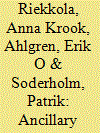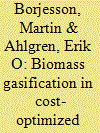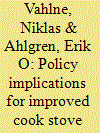|
|
|
Sort Order |
|
|
|
Items / Page
|
|
|
|
|
|
|
| Srl | Item |
| 1 |
ID:
109352


|
|
|
|
|
| Publication |
2011.
|
| Summary/Abstract |
It is increasingly recognised that GHG reduction policies can have important ancillary benefits in the form of positive local and regional environmental impacts. The purpose of this paper is to estimate the domestic ancillary pollution benefits of climate policy in Sweden, and investigate how these are affected by different climate policy designs. The latter differ primarily in terms of how the country chooses to meet a specific target and where the necessary emission reductions take place. The analysis relies on simulations within the energy system optimisation model TIMES-Sweden, and focuses on four non-GHG pollutants: Nitrogen Oxides (NOX), Non Methane Volatile Organic Compounds (NMVOC), inhalable particles (PM2.5), and Sulphur dioxide (SO2). The simulations permit detailed assessments of the respective technology and fuel choices that underlie any net changes in the estimated ancillary effects. The results indicate that the ancillary benefits constitute a far from insignificant share of total system costs, and this share appears to be highest in the scenarios that entail the largest emission reductions domestically. This result reflects the fact that carbon dioxide emission reductions abroad also implies a lost opportunity of achieving substantial domestic welfare gain from the reductions of regional and local environmental pollutants.
|
|
|
|
|
|
|
|
|
|
|
|
|
|
|
|
| 2 |
ID:
093481


|
|
|
|
|
| Publication |
2010.
|
| Summary/Abstract |
Biomass integrated gasification combined cycle (BIGCC) plants could, in combined heat and power (CHP) generation, increase the power-to-heat ratio compared to conventional biomass steam turbine plants. Furthermore, biomass gasification could also be used for the efficient production of biofuels for transport. In this study, different applications of biomass gasification in connection to district heating (DH) are analysed and contrasted to conventional technology options. An application of the cost-optimizing energy system model MARKAL with a detailed description of the DH sector in a southwestern region of Sweden was developed within the study and used in the analysis. Policy measures for CO2 reduction and for promotion of "green" electricity are assumed, and required subsidy levels for large-scale production of transport biofuels are calculated. The model also operates with different supplies of biomass: a local supply at a lower cost and an international supply of refined biomass at a slightly higher cost. The study shows that investments in BIGCC CHP are often cost-efficient in cases with low ambitions regarding transport biofuels. However, due to limitations in heat demand and in local, lower cost, supply of biomass, investment in biofuel production means less investment in BIGCC CHP and, thereby, a smaller electricity production.
|
|
|
|
|
|
|
|
|
|
|
|
|
|
|
|
| 3 |
ID:
094869


|
|
|
|
|
| Publication |
2010.
|
| Summary/Abstract |
This paper focuses on energy system development of the three largest Association of South East Asian Nations (ASEAN) countries: Indonesia, Philippines and Vietnam. The energy infrastructures in these counties are in the process of rapid development and, therefore, technology choices are critical. Applying the energy system model MARKAL and scenario analysis, this paper examines and quantifies the role of clean and advanced energy technologies for efficient local resource exploitation and improving energy security and environmental conditions. The main focus is on the power sector and the paper also addresses the potential ASEAN markets for European energy technologies.
The paper concludes that there is a large potential market for clean and advanced energy technologies in the studied countries. If adopted, these technologies will bring several benefits like reduction in primary energy requirement, reduced investments requirement in the power sector and other parts of the energy infrastructure, reduced import of primary energy, reduced CO2 emissions and local pollution, reduced energy system costs and marginal cost of electricity supply. Finally, barriers for transfer and diffusion of advanced energy technologies are discussed.
|
|
|
|
|
|
|
|
|
|
|
|
|
|
|
|
| 4 |
ID:
128011


|
|
|
|
|
| Publication |
2014.
|
| Summary/Abstract |
Despite the long history of cook stove programs, very few have been successful, often only in areas where biomass is purchased or there is a biomass shortage. Several studies have described how rural households generally rely on several different fuels; which fuels are used may depend on various household characteristics such as location and income. This article explores possible consequences of variations in fuel usage for improved cook stove programs and how this may vary between different areas. Reductions of CO2 equivalent emissions and monetary savings are calculated for hypothetical cook stove deployment using data from a rural energy survey in the V?nh Phúc province of northern Vietnam. The results indicate that the areas may respond differently to the various stove options, both in terms of economy and emission reductions. Furthermore, there are large differences in emission reduction calculations when only Kyoto-gases are included and when non-Kyoto greenhouse agents are added. Assumptions regarding household behavior and stove efficiencies have large impacts on the results, indicating a need for further research on how improved cook stoves may influence households' fuel choices.
|
|
|
|
|
|
|
|
|
|
|
|
|
|
|
|
|
|
|
|
|